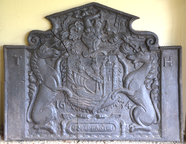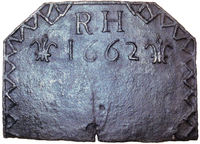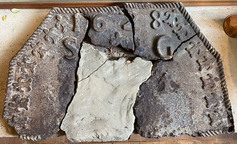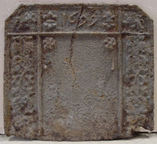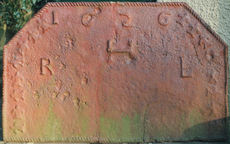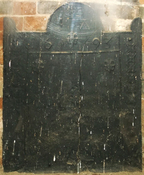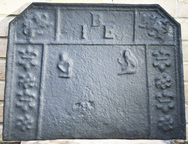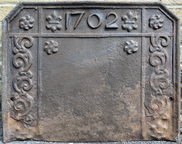-
952
Description: Rectangular joined to pediment by symmetrical scrolls; fillet edging with embattling inside; shield, helm, crest, supporters and mantling of the city of Bristol; date split by bottom of shield; inscription in an oval cartouche below shield; rectangular side extensions with twisted rope edging; initial on each extension.
Notes: The mismatched ‘3’ in the date is likely to have replaced a ‘1’ or ‘2’. The pattern-maker was also responsible for carving royal coats of arms in three West Country churches and a small number of series of firebacks in the first quarter of the 17th century. A variant without the side extension panels is no. 355.
Inscription: T H / 16 34 / ARMES BRISTOLL
Arms: City of Bristol
- Decoration tags:
- rectangular with detached pediment (shape)
- fillet and rope (edging)
- whole carved pattern
- individual letters
- individual numbers
- planklines
- extension panels
- armorial
- text
Manufactured: in 1634 possibly in the Forest of Dean area of England.
Current location: not known.
- Attached to series:
- Civic firebacks
- Bristol armorial group
-
860
Description: Canted rectangle; fillet edging (top and sides); top centre, initials, above date, between repeated fleur-de-lys stamp; from top corners to bottom corners, repeated V-shape pattern formed of stamped short fillets, with an L-shape inserted between the top two Vs on each side.
Notes: The fleurs de lys are of a distinctive style seen on a small group of firebacks.
Inscription: RH / 1662
- Decoration tags:
- rectangular with canted top corners (shape)
- fillet (edging)
- simple stamps
- carved stamps
- individual letters
- individual numbers
- heraldic
- text
- objects
Manufactured: in 1662 in the Forest of Dean area of England.
Current location: not known.
- Attached to series:
- Newent area group
- Fleur-de-lys firebacks
-
1258
Description: Broken and fragmentary; canted quasi-rectangular shape, with sides inclined; twisted rope edging; top centre, date with initials below separated by a fleur-de-lys; seven fleurs-de-lys down each side, pints perpendicular to rope edging; a fleur beneath each initial, possibly other fleurs and another initial missing in between.
Notes: The fleurs-de-lys are of a distinctive form apparently unique to this series of firebacks.
Inscription: 1628 / S G
- Decoration tags:
- rectangular with canted top corners (shape)
- rope (edging)
- simple stamps
- carved stamps
- heraldic
- text
Manufactured: in 1628 in the Forest of Dean area of England.
Current location: 31 Long Street, Tetbury, Gloucestershire, England.
- Attached to series:
- 1620s Dean series
-
348
Description: Composite; Arched rectangular shaped, armorial fireback, cavetto edging, with Stuart Royal arms, garter, supporters, crown and motto, and 1662 date above crown; this overlies a rectangular plate, with rope-effect, fillet edging; a pattern of four rosettes surrounding a fleur-de-lys, its stem terminating in a small buckle, is repeated on each side of the central armorial fireback, with the initials above; each rosette is stamped separately.
Notes: A variant, bearing the same date, but the initials, A B, and without the rosettes, is at Norton Manor, Malmesbury, Wiltshire.
Copies of this fireback are known.
Inscription: 16 62 / C P / HONI SOIT QVI MAL Y PENSE / DIEV·ET·MON DROIT
Arms: English Stuart royal
- Decoration tags:
- rectangular with round arch (shape)
- fillet (edging)
- carved stamps
- whole carved pattern
- composite
- individual letters
- armorial
- royal
- text
Manufactured: in 1662 possibly in the Forest of Dean area of England.
Current location: Tiverton Castle, Tiverton, Devon, England.
(part of the Colchester & Ipswich Museums Service museum group)
-
714
Description: Canted rectangle; cavetto moulded edging (top and sides); single horizontal fillet below canted corners and vertical fillet parallel to each side, dividing the fireback into two side panels, two top corner panels, top panel and main central panel; corner panels, lion passant stamp, left facing in right corner, right facing in left corner; top panel, date between double fleurs-de-lys stamps; side panels, suspended vine stamp repeated each side; centre panel, flower head stamp in each top corner.
Notes: The lion, flower head and double fleur stamps and linear division are identical to those on a group of firebacks, some of which are identified by the initials IB. The vine stamp in the side panels is not seen on other backs in the series.
Inscription: 1699
- Decoration tags:
- rectangular with canted top corners (shape)
- cavetto (edging)
- carved stamps
- individual numbers
- heraldic
- text
- animals
- plants
- objects
Manufactured: in 1699 in the Forest of Dean area of England.
Current location: not known.
- Attached to series:
- IB series
- Fleur-de-lys firebacks
-
956
Description: Canted rectangle; twisted rope edging; date along the top; initials in triad across the middle; fleur-de-lys stamp repeated eight times down each side, pointing to the side or up in the order (from the top): side (2), then alternately, up first.
Notes: The initials probably represent those of a married couple, the 'H' for their surname; it is unusual for twisted rope edging to continue along the bottom of the plate.
Inscription: 1626 / RHL
- Decoration tags:
- rectangular with canted top corners (shape)
- rope (edging)
- carved stamps
- individual letters
- individual numbers
- heraldic
- text
Manufactured: in 1626 in the Forest of Dean area of England.
Current location: not known.
- Attached to series:
- 1620s Dean series
-
1106
Description: Arched rectangular shape with quadrant extensions on top corners; twisted rope edging (top and sides); vertical rope line parallel to each side, forming two separate side panels; horizontal rope line joined to vertical lines enclosing the following: inside arch, initials IBA in triad; below initials, double fleur-de-lys stamp between split date 1693; below horizontal line, a double fleur stamp in each top corner of central lower panel; in each side panel, a single bead above a vertical sequence of squared cross stamps repeated nine times.
Notes: The distinctive squared cross and fleur stamps are seen on other firebacks; the initials in triad may relate to a husband and wife. The photograph had to be taken through a perspex sheet marked with bird droppings.
Inscription: IBA [triad] / 16 93
- Decoration tags:
- rectangular with round arch (shape)
- rope (edging)
- carved stamps
- individual letters
- individual numbers
- heraldic
- text
- objects
Manufactured: in 1693 in the Forest of Dean area of England.
Current location: Northgate House, Northgate, Warwick, Warwickshire, England.
- Attached to series:
- Newent area group
- Square cross Dean series 2
- Fleur-de-lys firebacks
-
1071
Description: Rectangular; cavetto-moulded edging; horizontal line of twisted rope parallel with the top; two vertical lines of twisted rope parallel to the sides; fillet arc inside the corner of the horizontal and vertical lines; each arc encloses 28 (left) or 29 (right) 'daisy heads', with a line of the same stamp around the inside of the lines; in the top corners, the split date; in the top compartment, initials, TH, between 22 hollow saltires, each with a central bead, in a horizontal line, 11 on each side; in each side compartment, at least seven hollow saltires arranged vertically.
Notes: The fireback is partially sunk into the floor of the hearth, so its height is not known.
Inscription: 16 TH 99
- Decoration tags:
- rectangular (shape)
- cavetto (edging)
- carved stamps
- individual numbers
Manufactured: in 1699 in the Forest of Dean area of England.
Current location: in private hands, Westbury on Severn, Gloucestershire, England.
- Attached to series:
- Hollow saltire series
- Newent area group
-
1304
Description: Canted rectangular shape with inclined sides; cavetto-moulded edging (top and sides); horizontal fillet parallel to the top edge divided by two further fillets, in the centre the initials in capitals in triad, and at each end a lion rampant stamp facing inwards and inclined upwards towards the centre; below the lions, two inclined vertical fillets, parallel to the sides of the plate, each enclosing down the sides a double fleur-de-lys stamp and a flowerhead stamp repeated twice on each side and arranged alternately; in the panel below the initials, two different animal figures of indeterminate type, possibly monkeys.
Notes: The rampant lion, double fleur and flowerhead stamps have all been noted on other firebacks in a series identified on most backs with the initials I and B at the base of the plate. The initials are not present on this casting although the inclusion of I and B in the triad at the top could suggest that this fireback was personal to the founder and his wife. Of note are the impressions of the lions which overstamp the fillet below, indicating that they were placed after the fillet. Unlike the other backs in this series this example is undated. Wincanton Auctions, 24 Oct 2024, lot 540 (£35); Bellmans Auction, Wisborough Green, 13 May 2025, lot 562 (£60).
Inscription: IBE [triad]
- Decoration tags:
- rectangular with canted top corners (shape)
- cavetto (edging)
- carved stamps
- individual letters
- heraldic
- text
- animals
- plants
Manufactured: in the late-17th to early-18th century in the Forest of Dean area of England.
Current location: not known.
- Attached to series:
- IB series
- Fleur-de-lys firebacks
-
1313
Description: Canted rectangle; cavetto-moulded edging; three horizontal strips bearing a fine repeated ribbing: one horizontal below canted corners, and two vertical strips parallel to each side, dividing the fireback into two side panels, two top corner panels, top panel and main central panel; in each top corner panel a flower head stamp; top panel, date between a repeated double fleur-de-lys stamp; in each side panel, a stamp formed of an arrangement of scrolled tendrils, with a double fleur-de-lys stamp below; central panel, a flower head stamp in each top corner.
Notes: The divided structure of the decoration and the use of flower head and double fleur stamps places this fireback in the series identified on some castings with the initials IB. The tendril decoration in the side panels has not been seen on other backs in the series. Bellmans Auction, Wisborough Green, 8-10 Sep 2025, lot 703 (£30).
Inscription: 1702
- Decoration tags:
- rectangular with canted top corners (shape)
- cavetto (edging)
- carved stamps
- individual numbers
- heraldic
- text
- objects
Manufactured: in 1702 in the Forest of Dean area of England.
Current location: not known.
- Attached to series:
- IB series
- Fleur-de-lys firebacks
